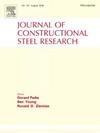大面积加劲腹板开口导致 C 型托梁功能丧失:实验
IF 4
2区 工程技术
Q1 CONSTRUCTION & BUILDING TECHNOLOGY
引用次数: 0
摘要
冷弯型钢 (CFS) C 型托梁(托梁)用于支撑地板和屋顶。在过去的三十年中,有关 CFS 托梁结构行为(局部、扭曲和整体屈曲模式)的知识已日趋成熟和完善。有关腹板开孔对结构强度影响的研究也取得了进展,重点是局部屈曲。然而,对于带有大型加劲腹板开孔(开孔)的桁架的整体行为,目前还没有足够的实验数据。挠度通常是控制桁架设计的参数,尤其是大跨度桁架。本文报告的是对大量开口深度超过腹板高度一半、宽度超过开口深度的桁架进行加载的实验结果。本文展示了如何获得桁架的等效惯性矩和允许荷载。桁架测试样本包括腹板高度、厚度、开口尺寸和间隔以及桁架跨度的多种组合。功能损失(损失)是根据开口造成的挠曲挠度增加来测量的。结果发现,某些组合的损失可以忽略不计,而某些组合的损失则高达 35%。间距越近、开口越大,损耗越大;出乎意料的是,跨度越短,损耗也越大。本文介绍的研究强调了验证计算机模型、更新国家设计标准、估算用于计算有效惯性矩的类似冲孔几何形状造成的损失以及最终确定 CFS 托梁允许荷载的必要性,并提供了实验数据。本文章由计算机程序翻译,如有差异,请以英文原文为准。
Functional loss of C- joists due to large stiffened web openings: Experiments
Cold-Formed Steel (CFS) C-Joists (joists) support floors and roofs. Knowledge of the structural behavior (local, distortional, and, global buckling modes) of CFS joists has matured and been codified over the last three decades. Research has also advanced estimating the influence of web openings on structural strength focusing on local buckling. However, insufficient experimental data is available for the global behavior of joists with large stiffened web openings (openings) that are increasingly becoming popular to allow the passage of utilities. Deflection is often the controlling joist design parameter, especially for large spans. Reported herein are results of experiments conducted by loading a large number of joists with openings deeper than half of the web height and wider than the opening's depth. It is demonstrated herein how an equivalent moment of inertia and allowable load for joists can be obtained. Joist test specimens cover multiple combinations of web heights, thicknesses, sizes and intervals of openings, and, joist spans. The functional loss (loss) is measured in terms of the increase of flexural deflection due to openings. The loss was found to be negligible for some combinations and as high as 35 % for some others. Closer spacing and larger openings result in greater loss; and, unexpectedly, shorter spans also increase the loss. Research presented herein underscores the need, and offers experimental data, for validating computer models, updating national design standards, estimating loss due to similar punchout geometries for computing the effective moment of inertia, and, ultimately, the allowable load for CFS joists.
求助全文
通过发布文献求助,成功后即可免费获取论文全文。
去求助
来源期刊

Journal of Constructional Steel Research
工程技术-工程:土木
CiteScore
7.90
自引率
19.50%
发文量
550
审稿时长
46 days
期刊介绍:
The Journal of Constructional Steel Research provides an international forum for the presentation and discussion of the latest developments in structural steel research and their applications. It is aimed not only at researchers but also at those likely to be most affected by research results, i.e. designers and fabricators. Original papers of a high standard dealing with all aspects of steel research including theoretical and experimental research on elements, assemblages, connection and material properties are considered for publication.
 求助内容:
求助内容: 应助结果提醒方式:
应助结果提醒方式:


